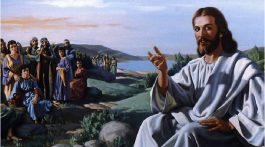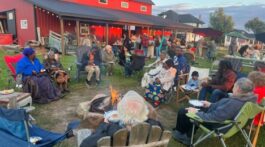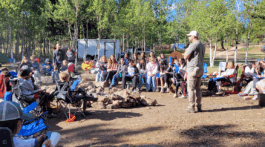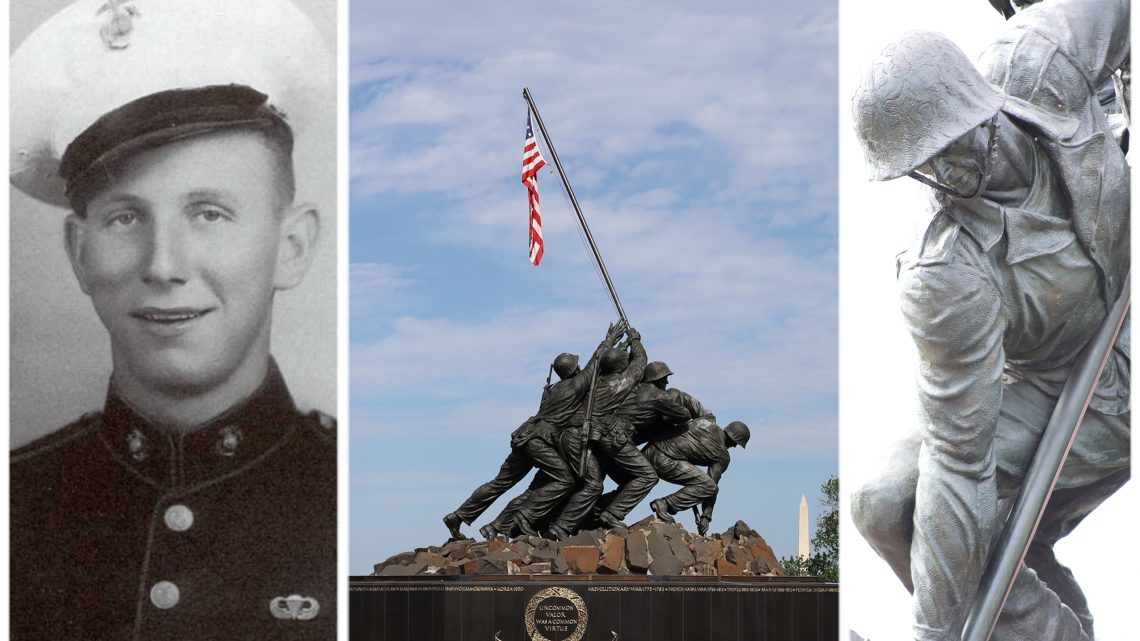On February 23, 1945, a small group of United States Marines raised the American flag on the rocky summit of Mount Suribachi on the island of Iwo Jima after clearing it of Japanese resistance. Joe Rosenthal’s photograph of the iconic event is arguably the most famous picture from World War II. The scene captures a moment in time now immortalized in the nation’s first national memorial to honor servicemen, a bronze sculpture erected in 1954 in Arlington, Virginia, across the Potomac River from Washington, DC. Formally known as the United States Marine Corps War Memorial, its presence ensures that the story of this moment on Iwo Jima is retold over and over. Few people are aware of the complete stories of these six men. Fewer still know that one of the Marines was a Seventh-day Adventist. If you are among the few, you have likely read James Bradley’s book, Flags of Our Fathers.
Origins
The Marine crouched at the base of the flag pole represents Corporal Harlon Henry Block. Born on November 6, 1924, in Yorktown, Texas, Harlon was the third of Edward Frederick Block’s (1896-1968) and Ada Belle Brantley’s (1896-1980) six children, who also included Edward Frederick, Jr. (1920-2002), Maurine Ada (1922-2014), James Larry (1926-2000), Daniel Corwin, known as Corky (1930-1985), and Melford Lawrence (1933-2005).
The senior Edward Block was the son of German immigrants. In fact, Ed and Belle were members of a German-speaking Lutheran congregation when their first son was born on September 16, 1920. His baptism was recorded in German in the church records.
Around the time of Harlon’s birth, two events profoundly changed the family. The Blocks moved to a farm near Weslasco, Texas, and Belle, a nurse by training, attended meetings conducted by Elder O. J. Corwin. This led to the family’s conversion to the Seventh-day Adventist Church and charter membership in the new McAllen-Pharr church. Neither of these changes made for a completely happy family. Belle did not particularly like life on a farm. Ed was not so committed to his new church as his wife desired.
The Block children were enrolled in the church school. Harlon was baptized on May 19, 1934, but by the time he reached high school he was exhibiting a rebellious streak. After two years at Valley Grande Academy, he was expelled. Already attracted to the glory of the high school football field, Harlon decided to enroll in the public high school. Much to his mother’s bitter disappointment, he did so with his father’s approval.
Despite his success on the football field, Harlon’s rebellious streak was not quite over. One afternoon in January 1943 during his senior year, he and other members of the football team, including Glen Cleckler, decided to skip afternoon classes, drive to another nearby town, Harlingen, and watch a movie. Wondering what excuse to give the principal, Cleckler suggested they visit the Marine recruiting office. Told they could not enlist until after graduation, the boys returned to school with their enlistment forms, little knowing the principal would call their bluff, expedite an early graduation, and see the boys enlisted in the Marine Corps on February 18, 1943. Under age, Harlon needed a parent’s signature to enlist. His mother refused to sign, but his father did.
Making History
Harlon was sent to boot camp near San Diego. After parachute training, he shipped out to the South Pacific on November 15, 1943. His horrific experiences on Bougainville finally sobered him to the seriousness of what he had done and he began to think he would not survive the war. Harlon briefly returned to California—including a short furlough to Texas—in 1944 where he was reassigned to the Second Platoon, E Company, 2nd Battalion, 28th Marine Regiment, 5th Marine Division. In September 1944, his unit was sent to Hawaii to prepare for the invasion of Iwo Jima. About this time, Harlon was promoted to corporal. He had also started rethinking his spiritual life, becoming increasingly uncomfortable with the duties of a Marine. He disclosed to his oldest brother and sister, as well as several friends, that he did not expect to survive the war.
On the morning of February 23, 1945, after days of brutal fighting, the guns on Mount Suribachi fell silent. A forty-man patrol was sent to the top of the 554-foot high volcanic crater. Their primary mission was to determine whether the Japanese threat had been eradicated. They also carried a small American flag with them. Sergeant Lou Lowery, who was part of this group, had a camera and took pictures when the Marines hoisted this flag. However, his is not the photograph in the history books.
It was soon decided to replace the flag with a larger one. Four men from the 2nd Platoon, including Harlon, were actually given the task of stringing phone wire up the side of the mountain for radio communication. As they started up the height, another of the Marines, Rene Gagnon, was handed a large flag originally salvaged from Pearl Harbor, and told to have Lieutenant Schrier replace the original flag with this larger one. The men from the 2nd Platoon were accompanied by several photographers including Joe Rosenthal of the Associated Press.
Although the fighting on Iwo Jima was of intense interest to Americans back home, the Marines themselves thought little of the flag on Mount Suribachi. Certainly, the first flag was considered the more important of the two. It was all a fleeting, emotional moment of victory and then it was over. In fact, it was over so fast Rosenthal was not even sure he had caught a good photograph, snapping it without looking through the viewfinder. He had to send the film to Guam for processing and then censors decided which photographs would make it back to the United States. Two days later, on February 25, 1943, the photograph was published before any of those involved had any idea something special had happened.
Meanwhile, in the United States in the absence of facts that the Marine Corps did not consider particularly important, the popularity of Rosenthal’s photograph took on a life of mythic proportions that would take years to unravel. The myth of most immediate consequence was that the battle was over by the time the flag was raised. It was not. Harlon would never know the aftermath of this moment. He died in battle on March 1, 1945, six days after that euphoric moment on Mount Suribachi and the same day that Florida Congressman Joseph Hendricks introduced a bill authorizing the erection of a monument based on Rosenthal’s photograph.
Initially buried on Iwo Jima in the Fifth Marine Division Cemetery, Harlon’s remains were returned to his family in Weslasco, Texas, where he was buried on January 24, 1949. His body was moved and reinterred again on February 19, 1995, this time on the campus of the Marine Military Academy in Harlingen, Texas. His final grave is near Felix W. de Weldon’s full-sized working model from which he created the national monument in Arlington, Virginia.
Aftermath
Harlon’s afternoon lark in 1943 not only determined his fate, it altered the course of his entire family. In grief, the tension between Ed and Belle worsened. Belle was convinced from the very first time she saw Rosenthal’s photograph that Harlon was one of the Marines. As he was initially misidentified, Belle suffered the ridicule of family and friends who did not believe her for two years. This was just one more factor that caused Ed and Belle to separate and eventually divorce. They each later remarried.
Edward Frederick, Jr., served in the Air Force from 1952 to 1969. Maurine married Daniel Avery Mitchell (1924-2003) and became a missionary teacher in Taiwan. Her husband, a physician, was director of the Adventist hospital in Taiwan from 1956 to 1961. He later taught at Loma Linda University. James Larry served in the Army between 1946 and 1947. Daniel Corwin followed his brother’s example, playing football for Weslasco High School and joining the Marine Corps during the Korean War.
In Harlon’s absence, his family appropriated his claim to fame. The obituaries of each brother, as well as their parents (the author was unable to obtain Maurine’s obituary at the time of writing), all mention Harlon’s participation in the flag raising to the exclusion, in one case, of the brother’s own life achievements. A park in Weslasco, Texas, was dedicated to Harlon Block. Today it is known as the Harlon Block Sports Complex. In 1959, Belle, now living in Yuma, Arizona, presided over a ceremony dedicating the city’s post office with its mural to her son. As already mentioned, the Marine Military Academy in Harlingen, Texas, created its own memorial. And of course, thousands visit the National Marine Corps War Memorial in Arlington, Virginia, each year with little idea of the full story of the men it portrays.
It is impossible to know what Harlon would have thought of all this. His obituary was published twice in the Southwestern Union Record, once when he died in 1945, and again when he was reinterred in 1949. Contributor M. H. Jensen claimed that “Harlon looked forward to a life of service for his Master,” but this may have been more his mother’s wishful thinking than his real feelings. Evangelist Lyndon De Witt turned Harlon’s story into a modern parable.
Nor were the Block family and other Adventists the only ones to appropriate the story. Although Harlon and two more of the young men in Rosenthal’s photograph, died on Iwo Jima, the United States government exploited those who survived to raise $26 million in a six-week war bond tour from May 14 to June 30, 1945. It made celebrities out of the young Marines who saw themselves as anything but heroes. Each suffered his own emotional trauma that would haunt the rest of their lives. It is likely Harlon would have suffered similarly.
Harlon Block sought the limelight of the athletic field as a boy. He could have had little idea that an insignificant moment on a field of battle, haphazardly caught on film, would preserve his name for posterity.










